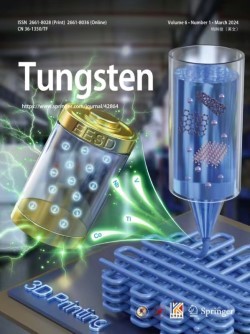用含水氧化锆分离硫酸镍溶液氟化
IF 11.2
3区 材料科学
Q2 MATERIALS SCIENCE, MULTIDISCIPLINARY
引用次数: 0
摘要
摘要氟化物是生产电动汽车电池所需的硫酸镍中的一种杂质。对含水氧化锆(HZO)去除硫酸镍溶液中的氟化物进行了评价。pH值为4时除氟效果最好,考虑到Zr溶解度,最佳pH值为4 ~ 5。由于氟化氢和氟化锆的存在,氟化物的可用性随着pH值的增加而降低。氟的去除最初是快速的,在7分钟内去除50 wt.%,然后在72小时后缓慢去除68 wt.%,并遵循二级速率动力学。氟的去除主要是离子交换机制,并通过傅里叶变换红外光谱观察到产生的Zr-F键。与无盐溶液相比,硫酸镍的存在降低了负载能力。HZO通过5次加载和再生循环保持了吸附能力。本文章由计算机程序翻译,如有差异,请以英文原文为准。
Nickel sulfate solution fluoride separation with hydrous zirconium oxide
Abstract Fluoride is an impurity in nickel sulfate production, which is required for electric vehicle batteries. Hydrous zirconium oxide (HZO) was evaluated for removing fluoride from nickel sulfate solution. Maximum fluoride removal occurred at pH value 4 and optimal pH value is 4–5, considering Zr solubility. Fluoride availability decreases with pH due to hydrogen fluoride and zirconium fluoride aqueous species. Fluoride removal is initially rapid, with 50 wt.% removal in 7 min, followed by slow removal up to 68 wt.% after 72 h and follows second order rate kinetics. Fluoride removal was dominated by an ion exchange mechanism and resulting Zr–F bonds were observed using Fourier-transform infrared spectroscopy. The presence of nickel sulfate decreased loading capacity compared to a salt-free solution. HZO maintained adsorption capacity through five cycles of loading and regeneration.
求助全文
通过发布文献求助,成功后即可免费获取论文全文。
去求助
来源期刊
CiteScore
8.80
自引率
4.50%
发文量
8
期刊介绍:
Tungsten is the focal point of a peer-reviewed, international, and interdisciplinary research journal known as "Tungsten." This publication delves into various aspects of tungsten and its associated metals, encompassing molybdenum, cobalt, vanadium, tantalum, niobium, rhenium, zirconium, hafnium, titanium, manganese, along with their alloys and compounds.
Contributions are solicited across a spectrum of topics, spanning from fundamental inquiries into the science of tungsten and its counterparts, to the practical applications of these materials. The journal is committed to disseminating high-caliber articles concentrating on, though not confined to, the subsequent groundbreaking areas:
Nuclear materials
Low-dimensional materials
High-entropy materials
Energy conversion and storage materials
Polyoxometalates
Topological phases
Biomaterials
Catalytic materials
3D printing
Semiconductor materials
Magnetic materials
Negative thermal expansion materials
Advanced steel
Hard and refractory alloys
Metallurgy
Simulation and modeling
Surface treatment
Reuse and recycling
Its primary objective is to foster a broad exchange of research discoveries and enhance comprehension of advancements and innovative trajectories in both the science and applications of tungsten and its affiliated metals. These metals include molybdenum, cobalt, vanadium, tantalum, niobium, rhenium, zirconium, hafnium, titanium, manganese, and the diverse spectrum of alloys and compounds derived from them.

 求助内容:
求助内容: 应助结果提醒方式:
应助结果提醒方式:


